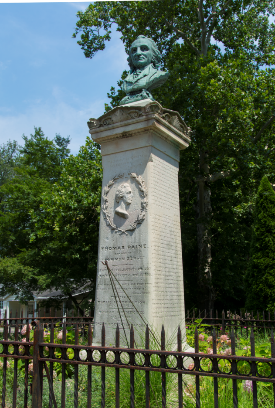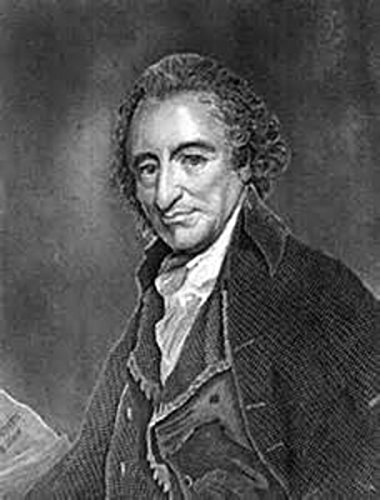
Thomas Paine was one of the founding fathers of the United States. His ideas as a political activist, philosopher, political theorist and revolutionary persist.
Below is an excerpt from a biography of Thomas Paine included with our books.
| Title | Published |
|---|---|
| Common Sense | 1776 |
| Rights of Man | 1791 |
Thomas Paine was born at Thetford, England on January 29, 1736.
From 1744 to 1749, Paine attended Thetford Grammar School. At the age of 13, he was apprenticed to his stay-maker father to make the thick stay ropes used on sailing ships.
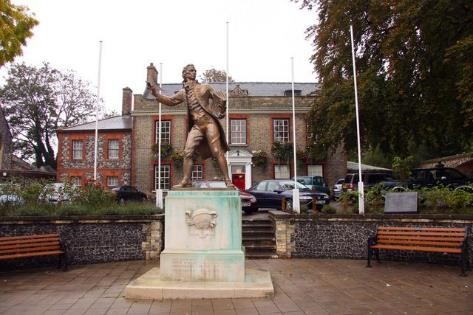
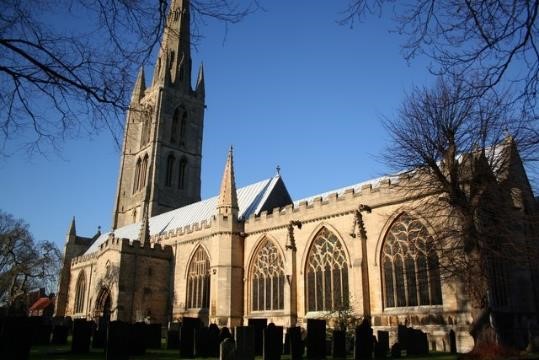
Basically, Thomas Paine did not receive any formal higher education. A connection to shipping and the sea helped Paine build his political and business knowledge base through learning by sailing on ocean as a privateer, traveling, and working as a master stay-maker in a shop in Sandwich, Kent established after returning to Britain in 1759.
On September 27, 1759, Thomas Paine married Mary Lambert. After Paine’s business collapsed at Sandwich, Kent, they moved to Margate. Mary and their child died due to an early labor at Margate.
In July 1761, Paine returned to Thetford to work as a supernumerary officer.
In December 1762, Paine became an Excise Officer in Grantham, Lincolnshire.
In August 1764, Paine was transferred to Alford in Lincolnshire, at a salary of £50 per annum.
On August 27, 1765, Paine was dismissed as an Excise Officer for claiming to have inspected goods he did not inspect. After the discharge, Paine worked as a stay-maker again.
In 1767, Paine was appointed as a school teacher in London.
On February 19, 1768, he was appointed to Lewes in Sussex, a town with a tradition of opposition to the monarchy and pro-republican sentiments. In Sussex, Paine first became involved in civic matters as a member of the Court Leet, the governing body for the town. He was also a member of the parish vestry.
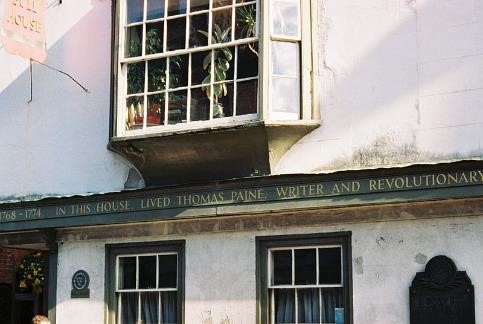
On March 26, 1771, at the age of 34, he married Elizabeth Ollive, his landlord’s daughter.
In summer of 1772, Paine published The Case of the Officers of Excise, a twenty-one-page article, and his first political work.
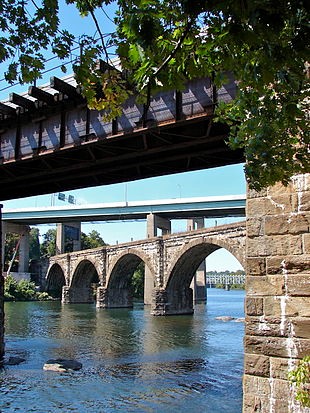
In spring of 1774, Paine’s tobacco shop failed and he formally separated from his wife Elizabeth. After that, Paine moved to London in September of 1774 and was introduced to Benjamin Franklin by mathematician, Fellow of the Royal Society and Commissioner of the Excise, George Lewis Scott.
During the meeting, Benjamin Franklin suggested him emigration to British colonial America. After an unsuccessful career in England, Thomas Paine emigrated from Great Britain to the American colonies in October of 1774 and arrived in Philadelphia on November 30, 1774. After arriving Philadelphia, Paine became a citizen of Pennsylvania by taking the oath of allegiance.
In January 1775, he became editor of the Pennsylvania Magazine.
Paine designed the Schuylkill River Bridge at Philadelphia in 1787 based on the Sunderland Bridge of 1796 over the Wear River at Wearmouth, England that was designed by him.
In the United States, Paine also received a British patent for a single-span iron bridge, developed a smokeless candle, and worked with inventor John Fitch in developing steam engines.
Thomas Paine is seen as the father of the American Revolution due to his pamphlets, especially Common Sense, which crystallized sentiment for independence in 1776.
It was published in Philadelphia on January 10, 1776. Common Sense is set to the future in a way that compels the readers to make an immediate choice. It offers a solution for Americans disgusted with and alarmed at the threat of dictatorship. Paine’s attack on monarchy in Common Sense was essentially an attack on George III and his great contribution was in initiating a public debate about independence which had previously been rather muted. One distinctive idea in Common Sense is the democratic peace theory.
Marylander James Chalmers vigorously attacked Common Sense in this titled Plain Truth in 1776. He said that Paine was a political quack and warned that without monarchy, the government would “degenerate into democracy”. John Adams, one of American revolutionaries, also objected to Common Sense by calling it a “crapulous mass”. Adams also published Thoughts on Government in 1776 to advocate a more conservative approach to republicanism.
In 1776, Paine published The American Crisis to inspire the Americans in their battles against the British army. General George Washington had The American Crisis read aloud to his solders.
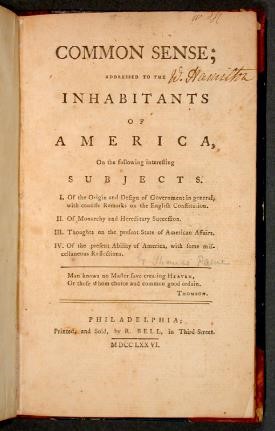
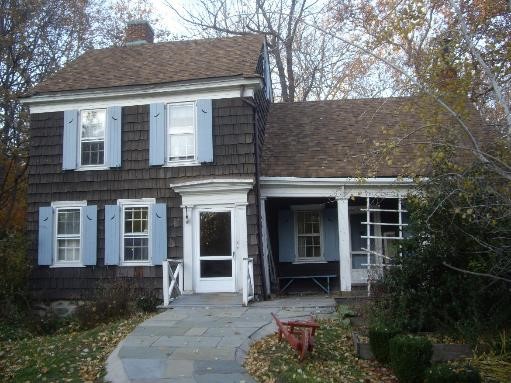

In 1777, Paine became secretary of the Congressional Committee on Foreign Affairs of the United States.
In 1778, Paine was assigned to secret negotiation underway with France of the United States.
Paine was excluded from the Committee in 1779 due to a scandal together with Paine’s conflict with Robert Morris.
In 1781, Paine accompanied John Laurens on his mission to France. Paine made influential acquaintances in Paris, and helped organize the Bank of North America to raise money to supply the army.
In 1785, Thomas Paine was given $3,000 by the U.S. Congress in recognition of his service to the nation. New York State also recognized his political services by presenting him with an estate, at New Rochelle, New York.
In 1783, Paine bought his only house on the corner of Farnsworth Avenue and Church Streets in Bordentown City, New Jersey and he lived in it periodically until his death in 1809.
In 1790, Edmund Burke published Reflections on the Revolution in France to blast against the French Revolution. In 1791, Paine publish his Rights of Man to refute it.
In 1792, Paine published his Rights of Man, Part the Second, Combining Principle and Practice to detail a representative government with enumerated social programs to remedy the numbing poverty of commoners through progressive tax measures.
After French Revolution, Paine was granted, along with Alexander Hamilton, George Washington, Benjamin Franklin and others, honorary French citizenship due to his supporter of the Revolution and was elected to the National Convention, representing the district of Pas-de-Calais. He voted against the execution of Louis XVI because of the way royalist France had come to the aid of the American Revolution and because of a moral objection to capital punishment in general and to revenge killings in particular.
Paine was arrested and imprisoned in December 1793 in Paris due to that a decree was passed at the end of 1793 excluding foreigners from their places in the Convention. He was released in November 1794 because of the work of the American Minister to France, James Monroe who successfully argued the case for Paine’s American citizenship.
In July 1795, he was re-admitted into the Convention and was one of only three members to oppose the adoption of the new 1795 constitution, because it eliminated universal suffrage, which had been proclaimed by the Montagnard Constitution of 1793.
In December 1797, Paine wrote Observations on the Construction and Operation of Navies with a Plan for an Invasion of England and the Final Overthrow of the English Government, in which he promoted the idea to finance 1,000 gunboats to carry a French invading army across the English Channel.
In 1800, Paine had a meeting with Napoleon. Napoleon claimed he slept with a copy of Rights of Man under his pillow. Paine condemned him as: “the completest charlatan that ever existed”.
In 1797, Tom Paine lived in Paris with Nicholas Bonneville and his family. Thomas Paine and Bonneville’s other controversial guests aroused the suspicions of authorities. Bonneville was then jailed and took refuge with his father in Evreux in 1800 due to that Bonneville hid the Royalist Antoine Joseph Barruel-Beauvert at his home.
Paine remained in France until 1802. In 1802, Paine left France for the United States at President Jefferson’s invitation. Paine returned to the United States with paying passage for Bonneville’s wife, Marguerite Brazier and their three sons, to whom Paine was godfather since Bonneville was still jailed by Napoleon.
In 1804 Paine returned to the subject of attacking England by writing To the People of England on the Invasion of England.

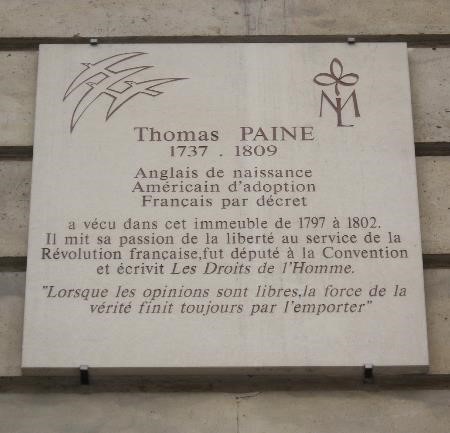
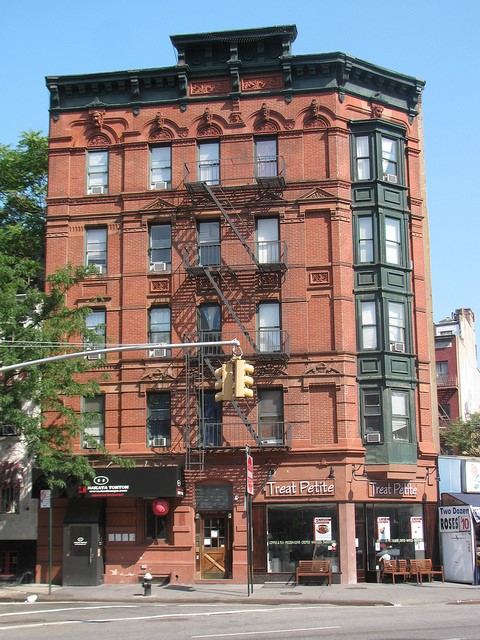
Paine returned to the United States at a time of the Second Great Awakening and of great political partisanship. The religiously devout disliked him due to his The Age of Reason and the Federalists attacked him due to his Common Sense, his association with the French Revolution, his friendship with President Jefferson, and his Letter to attack Washington that were published six years before his return.
Paine died at the age of 72, at 59 Grove Street in Greenwich Village, New York City, on the morning of June 8, 1809.
Marguerite Brazier took care of Paine at the end of his life and buried him after his death on June 8, 1809. Paine’s body was brought to New Rochelle, but the Quakers would not allow it to be buried in their grave yard as per his last will, so his remains were buried under a walnut tree on his farm.
In his will, Paine left the bulk of his estate to his friends Nicholas Bonneville and Marguerite Brazier, including 100 acres of his farm so they could maintain and educate their sons. In 1814, the fall of Napoleon finally allowed Bonneville to rejoin his wife in the United States where he remained for four years before returning to Paris to open a bookshop.
At the time of his death, most American newspapers reprinted the funereal notice from the New York Evening Post, which read in part: “He had lived long, did some good, and much harm.” Only six mourners came to his funeral, two of whom were black, most likely freedmen.
In 1969, the United of America issued a Prominent American stamp to honor Thomas Paine.
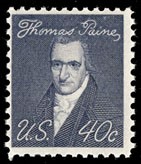
In 1969, the United of America issued a Prominent American stamp to honor Thomas Paine.
